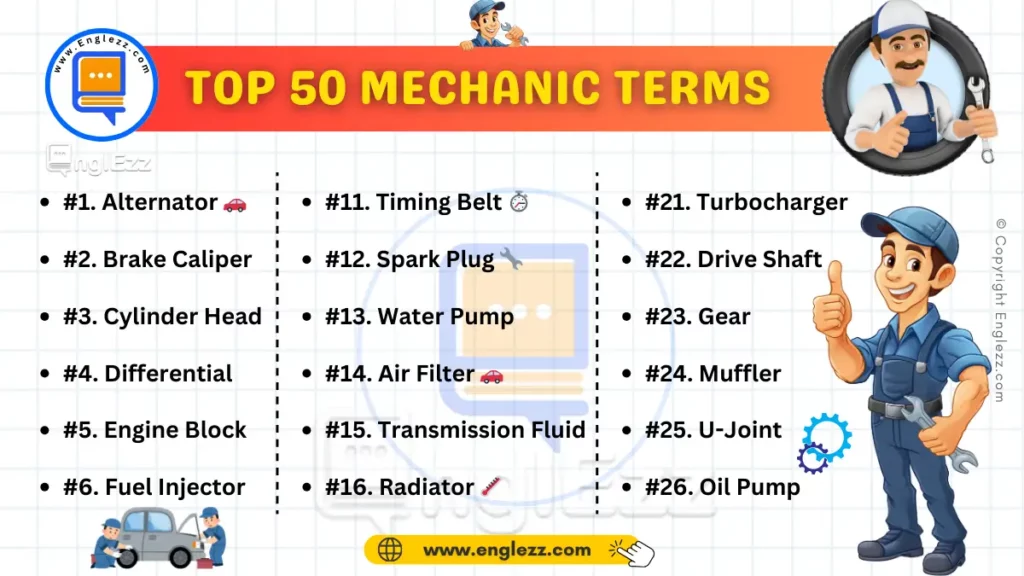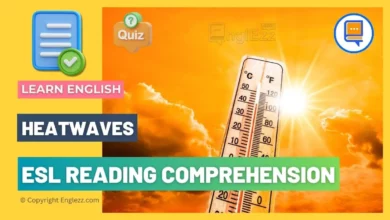Mechanics play a crucial role in maintaining and repairing vehicles, and their work is full of specialized terminology. Understanding these terms is essential for anyone involved in the automotive industry, whether you’re a professional mechanic, a car enthusiast, or just someone interested in how vehicles work. In this comprehensive guide, we will explore the 50 most common mechanic English terms, providing clear definitions, phonetic transcriptions, and practical examples to help you grasp their meanings and applications.
Table of Contents
- 50 Mechanic English Terms Every Student Must Know
- #1. Torque 🔧
- #2. Cylinder Head 🚗
- #3. Piston 🛠️
- #4. Crankshaft 🏎️
- #5. Timing Belt ⏱️
- #6. Fuel Injector ⛽
- #7. Radiator 🚙
- #8. Alternator 🔋
- #9. Transmission 🚙
- #10. Differential 🛠️
- #11. Alternator Belt 🚗
- #12. Brake Caliper 🛠️
- #13. Exhaust Manifold 🚗
- #14. Spark Plug 🔧
- #15. Oil Filter 🛠️
- #16. Battery Terminal 🔋
- #17. Wheel Hub 🚗
- #18. Shock Absorber 🚙
- #19. Head Gasket 🔧
- #20. Air Filter 🛠️
- #21. Radiator Hose 🚗
- #22. Transmission Fluid 🛠️
- #23. Drive Shaft 🚗
- #24. Power Steering Pump 🛠️
- #25. Timing Chain ⏱️
- #26. Battery Cable 🔋
- #27. Muffler 🚗
- #28. Thermostat 🌡️
- #29. Clutch Pedal 🚗
- #30. ABS (Anti-lock Braking System) 🚙
- #31. Oil Pump 🛠️
- #32. Ball Joint 🛠️
- #33. Gasket Sealer 🔧
- #34. U-Joint 🚗
- #35. Sway Bar 🚙
- #36. Coolant Reservoir 🌡️
- #37. Idle Air Control Valve 🛠️
- #38. Differential Fluid 🚗
- #39. Ignition Coil 🔧
- #40. Drive Belt 🚗
- #41. Turbocharger 🛠️
- #42. Exhaust Pipe 🚗
- #43. Fuel Pump ⛽
- #44. Catalytic Converter 🚗
- #45. Timing Gear ⏱️
- #46. Ignition System 🔧
- #47. Radiator Cap 🌡️
- #48. Air Filter 🚗
- #49. Spark Plug 🔧
- #50. Water Pump 🌊
- Mechanic English Terms Table
- Conclusion
50 Mechanic English Terms Every Student Must Know
This guide is designed to enhance your vocabulary, improve your communication with professionals, and give you a deeper insight into the world of mechanics. Dive in to expand your knowledge and ensure you’re well-versed in the essential language of the automotive world!
#1. Torque 🔧
Definition: A measure of rotational force applied to an object.
Phonetic Transcription: /tɔrk/
Examples:
- The mechanic adjusted the torque on the lug nuts to ensure they were tightened properly.
- “Engine performance is often measured by the amount of torque it produces.”
#2. Cylinder Head 🚗
Definition: The top part of an engine’s cylinder block that contains the valves and spark plugs.
Phonetic Transcription: /ˈsɪlɪndər hɛd/
Examples:
- “A cracked cylinder head can lead to coolant leaks and overheating.”
- “Replacing the cylinder head gasket was necessary to stop the engine from losing compression.”
#3. Piston 🛠️
Definition: A cylindrical component that moves up and down within the cylinder of an engine.
Phonetic Transcription: /ˈpɪstən/
Examples:
- “The piston in the engine was worn out and needed to be replaced.”
- In a four-stroke engine, pistons play a crucial role in the power cycle.
#4. Crankshaft 🏎️
Definition: A shaft that converts the linear motion of the pistons into rotational motion.
Phonetic Transcription: /ˈkræŋkˌʃæft/
Examples:
- “The crankshaft is essential for turning the pistons’ movement into useful power.”
- “Engine vibrations can often be traced back to issues with the crankshaft.”
#5. Timing Belt ⏱️
Definition: A belt that synchronizes the rotation of the crankshaft and camshaft.
Phonetic Transcription: /ˈtaɪmɪŋ bɛlt/
Examples:
- “Regularly replacing the timing belt can prevent engine damage.”
- “The mechanic checked the timing belt for signs of wear during the inspection.”
#6. Fuel Injector ⛽
Definition: A component that sprays fuel into the engine’s combustion chamber.
Phonetic Transcription: /fjul ɪnˈdʒɛktər/
Examples:
- “Clogged fuel injectors can lead to poor engine performance and increased fuel consumption.”
- “The mechanic cleaned the fuel injectors to improve the car’s efficiency.”
#7. Radiator 🚙
Definition: A device used to cool the engine by transferring heat from the coolant to the air.
Phonetic Transcription: /ˈreɪdiˌeɪtər/
Examples:
- “The radiator helps prevent the engine from overheating.”
- “A leaking radiator can cause serious engine problems if not addressed promptly.”
#8. Alternator 🔋
Definition: A generator that produces electrical power to charge the battery and power the vehicle’s electrical systems.
Phonetic Transcription: /ˈɔːltərˌneɪtə/
Examples:
- “If the alternator fails, the vehicle may not start due to a dead battery.”
- The mechanic tested the alternator to ensure it was charging the battery correctly.

#9. Transmission 🚙
Definition: The system of gears that transmits power from the engine to the wheels.
Phonetic Transcription: /trænzˈmɪʃən/
Examples:
- “The transmission needs regular maintenance to ensure smooth gear shifts.”
- “A slipping transmission can cause the engine to rev higher without increasing speed.”
#10. Differential 🛠️
Definition: A gear system that allows the wheels on an axle to rotate at different speeds.
Phonetic Transcription: /ˌdɪfərˈɛnʃəl/
Examples:
- “The differential helps the wheels handle turns without excessive tire wear.”
- “A faulty differential can cause unusual noises and handling issues.”
#11. Alternator Belt 🚗
Definition: A belt that drives the alternator, ensuring it generates electricity.
Phonetic Transcription: /ˈɔːltərˌneɪtər bɛlt/
Examples:
- “A worn alternator belt can lead to the battery not charging properly.”
- “The mechanic replaced the alternator belt as part of the routine maintenance.”
#12. Brake Caliper 🛠️
Definition: A component that squeezes the brake pads against the rotor to slow or stop the vehicle.
Phonetic Transcription: /breɪk ˈkælɪpər/
Examples:
- “The brake caliper needs to be checked for leaks to ensure effective braking.”
- “Worn brake calipers can cause uneven braking and vibration.”
#13. Exhaust Manifold 🚗
Definition: A component that collects exhaust gases from the engine’s cylinders and directs them to the exhaust system.
Phonetic Transcription: /ɪɡˈzɔːst ˈmænɪfoʊld/
Examples:
- “A cracked exhaust manifold can lead to increased engine noise and reduced performance.”
- “The mechanic inspected the exhaust manifold for any signs of leaks.”
#14. Spark Plug 🔧
Definition: A device that ignites the air-fuel mixture in the engine’s combustion chamber.
Phonetic Transcription: /spɑrk plʌɡ/
Examples:
- “Faulty spark plugs can cause misfires and poor engine performance.”
- The mechanic replaced the spark plugs to restore optimal engine function.
#15. Oil Filter 🛠️
Definition: A filter that removes contaminants from engine oil to keep the engine running smoothly.
Phonetic Transcription: /ɔɪl ˈfɪltər/
Examples:
- Changing the oil filter regularly helps maintain engine health.
- “A clogged oil filter can lead to engine damage due to unfiltered oil.”
#16. Battery Terminal 🔋
Definition: The points where the battery cables connect to the battery.
Phonetic Transcription: /ˈbætəri ˈtɜrmɪnəl/
Examples:
- Corroded battery terminals can cause starting problems and electrical issues.
- “The mechanic cleaned the battery terminals to ensure a good connection.”
#17. Wheel Hub 🚗
Definition: The central part of the wheel assembly that connects to the axle and allows the wheel to rotate.
Phonetic Transcription: /wiːl hʌb/
Examples:
- “A damaged wheel hub can cause vibrations and noise while driving.”
- “The mechanic replaced the wheel hub bearing to eliminate the grinding sound.”
#18. Shock Absorber 🚙
Definition: A component that dampens the impact of bumps and vibrations to provide a smooth ride.
Phonetic Transcription: /ʃɑk əbˈzɔrbər/
Examples:
- “Worn shock absorbers can lead to a bumpy ride and poor handling.”
- “The mechanic replaced the shock absorbers to improve ride comfort.”
#19. Head Gasket 🔧
Definition: A seal that sits between the engine block and cylinder head, preventing leaks of coolant and combustion gases.
Phonetic Transcription: /hɛd ˈɡæskɪt/
Examples:
- “A blown head gasket can cause overheating and engine damage.”
- “The mechanic replaced the head gasket to fix the coolant leak.”
#20. Air Filter 🛠️
Definition: A filter that removes dirt and debris from the air entering the engine.
Phonetic Transcription: /ɛr ˈfɪltər/
Examples:
- “A dirty air filter can reduce engine efficiency and fuel economy.”
- “The mechanic recommended replacing the air filter to improve engine performance.”
#21. Radiator Hose 🚗
Definition: A hose that carries coolant between the engine and the radiator.
Phonetic Transcription: /ˈreɪdiˌeɪtər hoʊz/
Examples:
- “Leaking radiator hoses can lead to overheating and engine damage.”
- “The mechanic replaced the worn radiator hoses during the service.”
#22. Transmission Fluid 🛠️
Definition: The fluid used to lubricate and cool the transmission system.
Phonetic Transcription: /trænzˈmɪʃən flʊɪd/
Examples:
- “Low transmission fluid can cause shifting problems and overheating.”
- The mechanic checked the transmission fluid level and condition.
#23. Drive Shaft 🚗
Definition: A component that transmits torque from the engine to the wheels.
Phonetic Transcription: /draɪv ʃæft/
Examples:
- “A failing drive shaft can cause vibrations and noise during acceleration.”
- “The mechanic inspected the drive shaft for any signs of wear or damage.”
#24. Power Steering Pump 🛠️
Definition: A pump that provides hydraulic pressure to assist with steering.
Phonetic Transcription: /ˈpaʊər ˈstɪərɪŋ pʌmp/
Examples:
- “A failing power steering pump can make steering difficult and noisy.”
- “The mechanic replaced the power steering pump to restore proper steering function.”
#25. Timing Chain ⏱️
Definition: A chain that synchronizes the rotation of the crankshaft and camshaft, similar to the timing belt.
Phonetic Transcription: /ˈtaɪmɪŋ ʧeɪn/
Examples:
- “Timing chains are generally more durable than timing belts but still require inspection.”
- “A loose timing chain can lead to engine performance issues.”
#26. Battery Cable 🔋
Definition: Cables that connect the battery to the vehicle’s electrical system.
Phonetic Transcription: /ˈbætəri ˈkeɪbəl/
Examples:
- “Damaged battery cables can cause electrical failures and starting problems.”
- “The mechanic replaced the corroded battery cables to ensure reliable starts.”
#27. Muffler 🚗
Definition: A component that reduces noise from the exhaust system.
Phonetic Transcription: /ˈmʌflər/
Examples:
- “A damaged muffler can result in loud exhaust noises and reduced vehicle performance.”
- “The mechanic installed a new muffler to reduce engine noise.”
#28. Thermostat 🌡️
Definition: A device that regulates the engine’s temperature by controlling coolant flow.
Phonetic Transcription: /ˈθɜrməˌstæt/
Examples:
- “A malfunctioning thermostat can cause the engine to overheat or run too cool.”
- “The mechanic replaced the faulty thermostat to stabilize engine temperature.”
#29. Clutch Pedal 🚗
Definition: The pedal that engages and disengages the clutch in a manual transmission vehicle.
Phonetic Transcription: /klʌʧ ˈpɛdəl/
Examples:
- “Properly using the clutch pedal is essential for smooth gear shifts.”
- “The mechanic adjusted the clutch pedal to improve the engagement.”
#30. ABS (Anti-lock Braking System) 🚙
Definition: A system that prevents wheel lock-up during braking to maintain traction.
Phonetic Transcription: /ˌeɪ bi ˈɛs/
Examples:
- “ABS helps prevent skidding and loss of control during emergency stops.”
- “The mechanic checked the ABS system for proper functionality.”
#31. Oil Pump 🛠️
Definition: A pump that circulates oil throughout the engine to lubricate moving parts.
Phonetic Transcription: /ɔɪl pʌmp/
Examples:
- “A failing oil pump can lead to severe engine damage due to lack of lubrication.”
- “The mechanic replaced the oil pump to ensure proper oil circulation.”
#32. Ball Joint 🛠️
Definition: A component that allows the suspension system to move and pivot smoothly.
Phonetic Transcription: /bɔːl dʒɔɪnt/
Examples:
- “Worn ball joints can cause clunking noises and poor handling.”
- “The mechanic replaced the ball joints to restore vehicle stability.”
#33. Gasket Sealer 🔧
Definition: A substance applied to gaskets to prevent leaks and ensure a proper seal.
Phonetic Transcription: /ˈɡæskɪt ˈsiːlər/
Examples:
- “Gasket sealer is used to fix leaks in engine components and prevent fluid loss.”
- “The mechanic applied gasket sealer to the valve cover gasket to stop an oil leak.”
#34. U-Joint 🚗
Definition: A universal joint that allows for flexible rotation between the driveshaft and differential.
Phonetic Transcription: /juː dʒɔɪnt/
Examples:
- “A worn U-joint can cause vibrations and noise while driving.”
- “The mechanic replaced the U-joint to improve drive quality.”
#35. Sway Bar 🚙
Definition: A bar that reduces body roll during turns to improve vehicle stability.
Phonetic Transcription: /sweɪ bɑːr/
Examples:
- “A damaged sway bar can lead to poor handling and increased body roll.”
- “The mechanic inspected the sway bar to ensure it was properly attached.”
#36. Coolant Reservoir 🌡️
Definition: A container that holds excess coolant for the engine’s cooling system.
Phonetic Transcription: /ˈkuːlənt ˌrɛzəˈvwɑːr/
Examples:
- “The coolant reservoir needs to be checked regularly to prevent overheating.”
- “A cracked coolant reservoir can lead to coolant leaks and engine damage.”
#37. Idle Air Control Valve 🛠️
Definition: A valve that regulates the engine’s idle speed by controlling the air intake.
Phonetic Transcription: /ˈaɪdl ɛr kənˈtroʊl væl/
Examples:
- “A faulty idle air control valve can cause erratic idle speeds and stalling.”
- “The mechanic replaced the idle air control valve to fix idle issues.”
#38. Differential Fluid 🚗
Definition: The lubricant used to keep the differential gears running smoothly.
Phonetic Transcription: /ˌdɪfərˈɛnʃəl flʊɪd/
Examples:
- “Changing the differential fluid regularly helps prevent gear wear and noise.”
- “The mechanic checked the differential fluid level during the service.”
#39. Ignition Coil 🔧
Definition: A component that converts low voltage from the battery into high voltage for the spark plugs.
Phonetic Transcription: /ɪɡˈnɪʃən kɔɪl/
Examples:
- “A faulty ignition coil can lead to misfires and reduced engine performance.”
- “The mechanic replaced the ignition coil to restore proper engine function.”
#40. Drive Belt 🚗
Definition: A belt that transmits power from the engine to various components like the alternator and air conditioning compressor.
Phonetic Transcription: /draɪv bɛlt/
Examples:
- “A worn drive belt can cause noise and affect the performance of accessories.”
- “The mechanic replaced the drive belt to ensure all components were functioning properly.”
#41. Turbocharger 🛠️
Definition: A device that increases engine power by forcing more air into the combustion chamber.
Phonetic Transcription: /ˈtɜːrboʊˌʧɑːrdʒər/
Examples:
- “A malfunctioning turbocharger can reduce engine power and efficiency.”
- The mechanic serviced the turbocharger to enhance performance.”
#42. Exhaust Pipe 🚗
Definition: A pipe that directs exhaust gases from the engine out of the vehicle.
Phonetic Transcription: /ɪɡˈzɔːst paɪp/
Examples:
- “A damaged exhaust pipe can cause loud noises and reduce exhaust efficiency.”
- “The mechanic replaced the rusted exhaust pipe to ensure proper emission control.”
#43. Fuel Pump ⛽
Definition: A pump that supplies fuel from the tank to the engine.
Phonetic Transcription: /fjul pʌmp/
Examples:
- “A failing fuel pump can lead to engine stalling and poor acceleration.”
- “The mechanic replaced the fuel pump to restore proper fuel delivery.”
#44. Catalytic Converter 🚗
Definition: A component that reduces harmful emissions from the engine’s exhaust gases.
Phonetic Transcription: /ˈkætəˌlɪtɪk kənˈvɜːrtər/
Examples:
- “A clogged catalytic converter can reduce engine performance and fuel efficiency.”
- “The mechanic replaced the catalytic converter to meet emission standards.”
#45. Timing Gear ⏱️
Definition: A gear that works with the timing chain or belt to synchronize engine components.
Phonetic Transcription: /ˈtaɪmɪŋ ɡɪər/
Examples:
- Timing gears need to be checked for wear to avoid engine damage.
- “The mechanic replaced the timing gear to ensure accurate synchronization.”
#46. Ignition System 🔧
Definition: The system responsible for igniting the air-fuel mixture in the engine’s cylinders.
Phonetic Transcription: /ɪɡˈnɪʃən ˈsɪstəm/
Examples:
- “A malfunctioning ignition system can lead to hard starts and poor engine performance.”
- “The mechanic diagnosed the ignition system to identify any issues.”
#47. Radiator Cap 🌡️
Definition: A cap that seals the radiator and maintains pressure in the cooling system.
Phonetic Transcription: /ˈreɪdiˌeɪtər kæp/
Examples:
- “A faulty radiator cap can cause coolant leaks and overheating.”
- “The mechanic replaced the radiator cap to prevent coolant loss.”
#48. Air Filter 🚗
Definition: A filter that cleans the air entering the engine for combustion.
Phonetic Transcription: /ɛr ˈfɪltər/
Examples:
- “A clogged air filter can reduce engine efficiency and fuel economy.”
- “The mechanic replaced the air filter to ensure optimal engine performance.”
#49. Spark Plug 🔧
Definition: A component that ignites the air-fuel mixture in the engine’s cylinders.
Phonetic Transcription: /spɑrk plʌɡ/
Examples:
- “Worn spark plugs can cause misfires and poor engine performance.”
- “The mechanic replaced the spark plugs to ensure smooth engine operation.”
#50. Water Pump 🌊
Definition: A pump that circulates coolant through the engine and radiator.
Phonetic Transcription: /ˈwɔːtər pʌmp/
Examples:
- “A failing water pump can cause overheating and engine damage.”
- “The mechanic replaced the water pump to maintain proper cooling.”
Mechanic English Terms Table
| #1. Alternator 🚗 | #11. Timing Belt ⏱️ | #21. Muffler 🚗 |
| #2. Brake Caliper 🚗 | #12. Spark Plug 🔧 | #22. Drive Shaft 🚗 |
| #3. Cylinder Head 🛠️ | #13. Water Pump 🌊 | #23. Power Steering Pump 🛠️ |
| #4. Differential 🛠️ | #14. Air Filter 🚗 | #24. Turbocharger 🛠️ |
| #5. Engine Block 🚗 | #15. Transmission Fluid 🚗 | #25. U-Joint 🚗 |
| #6. Fuel Injector 🚗 | #16. Radiator 🌡️ | #26. Oil Pump 🛠️ |
| #7. Timing Chain ⏱️ | #17. Clutch Pedal 🚗 | #27. Ball Joint 🛠️ |
| #8. Transmission 🚗 | #18. ABS 🚙 | #28. Ignition Coil 🔧 |
| #9. Brake Pads 🚗 | #19. Sway Bar 🚙 | #29. Gasket Sealer 🔧 |
| #10. Drive Belt 🚗 | #20. Ignition System 🔧 | #30. Exhaust Pipe 🚗 |
Conclusion
Mastering mechanic terminology not only improves your understanding of automotive repairs but also boosts your confidence when dealing with vehicle issues. With the knowledge of these 50 essential mechanic terms, you’ll be able to communicate more effectively with professionals, follow repair procedures more accurately, and maintain your vehicle in optimal condition.
This guide has provided you with clear definitions, phonetic transcriptions, and practical examples for each term. Remember, whether you’re an avid car enthusiast or a professional mechanic, staying informed about these terms is key to ensuring efficient and accurate vehicle maintenance.
Keep this guide handy for quick reference and continue expanding your automotive vocabulary to stay ahead in the world of vehicle repairs and maintenance.









Discover the essential mechanic terms you need to know! From the basics of brake calipers to the complexities of turbochargers, this guide covers it all. 💡🚗 Dive in and enhance your automotive vocabulary today. Don’t forget to follow and like @EnglEzz for more insightful content.
.
https://www.englezz.com/most-common-mechanic-english-terms/
.
#EnglEzz #vocabulary #linguistics #learnenglish #mechanicterms #automotive #carrepair #vehiclemaintenance #engineterms